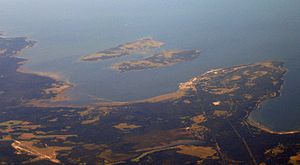Pakri Islands
| Pakri Islands | ||
|---|---|---|
| Location of the Pakri Islands | ||
| Waters | Gulf of Finland | |
| Geographical location | 59 ° 20 ' N , 23 ° 53' E | |
|
|
||
| Number of islands | 2 | |
| Total land area | 24.5 km² | |
| Residents | 8 (2011) | |
| Aerial view of the two islands | ||
Pakri Islands ( Estonian Pakri saared , Swedish Rågöarna , singular Rågö ) denotes the two Estonian islands Suur-Pakri (“Groß Pakri”, Swedish: Stora Rågö , “Groß Rågö”) and Väike-Pakri (“Klein Pakri”, Swedish: Lilla Rågö , “Little Rågö”) in the Gulf of Finland .
The islands are 2.5 km from the town of Paldiski and administratively belong to the municipality of Lääne-Harju . In 1345 they were settled by five Swedish families from the area around Padise Monastery . They were given the Swedish name Rågöarna ( rye islands). In 1934 the islands were an independent municipality with five villages and 354 inhabitants. In August 1944, the population was evacuated to Sweden in connection with the Soviet occupation of Estonia .
The islands served as a stationing point for the Soviet Army and a training ground for bombing until 1992 . All original buildings, the two churches (built in 1825 and 1890) and the historic cemetery were completely destroyed. The two islands are connected by a dam that the army had built in the early 1950s.
There are numerous erratic boulders and a rich flora and fauna on both islands . The islands have been a nature reserve since 1998, where hunting and fishing are prohibited. The Pakri Islands are popular and worthwhile destinations for nature lovers and tourists.
Suur-Pakri ( Stora Rågö, Groß-Pakri )
Suur-Pakri (western island) has an area of 11.6 km². The highest point is 4 m above sea level. There is good spring water on the island.
Väike-Pakri ( Lilla Rågö, Klein-Pakri )
Väike-Pakri (eastern island) is about 12.9 km² slightly larger than the neighboring island (11.6 km², the earlier name was based on the number of inhabitants). The highest point is 13 m above sea level. The island has been populated again since the 2000s.
Web links
- Väike-Pakri and Suur-Pakri websites
- Christian Bornhaupt: Draft of a geographical-statistical-historical description of Liv, Ehst and Kurland, together with a wall map . WF Häcker, Riga 1855, pp. 26-27.








